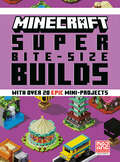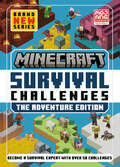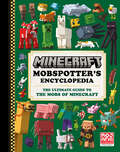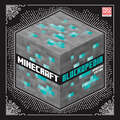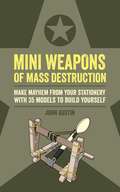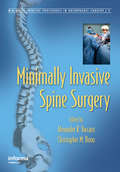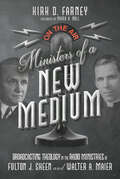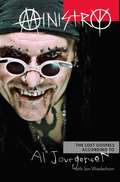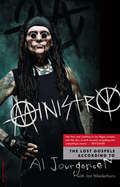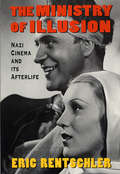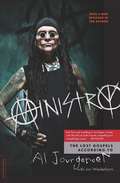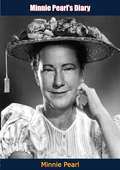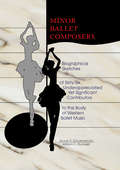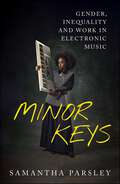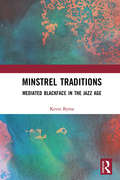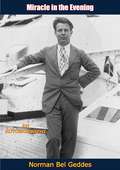- Table View
- List View
Minecraft: Super Bite-Size Builds (Minecraft)
by Mojang AB The Official Minecraft TeamThe next book in the popular Bite-Size Builds series, following Bite-Size Builds and Amazing Bite-Size Builds. Learn how to design, build and customize over twenty new mini-projects in Minecraft. With detailed instructions, block hacks and build tips, this book will teach you new tricks and help you practice old skills as you create bite-size builds to impress your friends in Minecraft.
Minecraft: The Adventure Edition (Minecraft)
by Mojang ABSurvive 30 thrilling challenges in the first book of a new Minecraft series!Are you ready to take your Minecraft survival skills to another level? However you love playing, this book is packed with challenges that will improve your ability and inspire fun new ways to enjoy the world of Minecraft, on your own or with friends.Complete with amazing illustrations and expert tips throughout, this book will guide you on a journey to become a Minecraft survival expert!
Minecraft: The Ultimate Guide to the Mobs of Minecraft (Minecraft)
by Mojang AB The Official Minecraft TeamIt&’s time for adventure! Discover all there is to know about every mob in Minecraft in the official Mobspotter&’s Encyclopedia: The Ultimate Guide to the Mobs of Minecraft. You&’ll meet seven expert guides, who are full of stories of their fun experiences, and be taken on a tour to explore every corner of the Overworld. You&’ll even navigate to the Nether and experience the End dimension, on a thrilling journey to witness all seventy-nine mobs in existence.Discover how to survive a shoot-out with skeletons, dive for treasure with dolphins or risk a run-in with the Ender Dragon—and then start a whole new adventure of your own!
Minecraft: Updated Edition (Minecraft)
by Mojang AB The Official Minecraft TeamA completely updated version of the bestselling Minecraft: Blockopedia! Detailing each block found in the #1 game of all time, this is a must-have reference guide for all Minecrafters!This fully illustrated guide contains information on each of the blocks that make up the Minecraft world. It&’s a beautiful and comprehensive reference tool for beginners and more experienced players alike, with essential information on every block&’s properties, as well as little-known trivia and expert advice on what to do with each one! From basic plants and ores to enchantment tables and End stone, you&’ll find everything you need to know in the Blockopedia.
Minecrafter Architect: Amazing Starter Homes (Architecture for Minecrafters)
by Megan MillerThe Architecture for Minecrafters series is designed to encourage confidence and creativity by teaching kids to build a wide array of uniquely sophisticated structures. Each book in the series helps players follow blueprints to create impressive masterpieces that are as fantastic as they are functional. Minecrafter Architect: Amazing Starter Homes is the first in this inspiring new series. Guided by hundreds of in-game, step-by-step photos and simple instructions, kids will learn how to build one of ten amazing homes so that they can create interesting and reliable shelter anywhere they spawn. Igloo compounds, prairie houses, and llama ranches are just some of the killer designs that await them when they follow the techniques laid out in this book. With tips for adding d?cor and landscaping touches to their new builds, players can have fun bringing each new home to life. Perfect for beginner to advanced Minecrafters who want to learn more Includes hundreds of step-by-step, full-color photos to guide readers of all ages Helps encourage creativity and problem-solving skills Kids who want to try their hand at virtual design will love the tricks and tips inside this book! Minecrafter Architect: Amazing Starter Homes holds the valuable secrets they need to flex their in-game building skills.
Minecrafter Architect: Details and Inspiration for Creating Amazing Builds (Architecture for Minecrafters)
by Megan MillerBecome a Master Builder of Structures! <P><P>Tired of the same old 9x9 cobblestone cubes? Stuck figuring out what type of windows to add to your mansion? Minecrafter Architect: The Builder’s Idea Book will solve your builder’s block, with dozens of examples of window treatments, entranceways, roofs, walls, paths, road, bridges, floorplans, block palettes, and more. Copy them exactly or use them as inspiration, and you’ll be mastering the art of creating unique and detailed Minecraft builds. <P><P>Guided by hundreds of in-game, step-by-step photos and simple instructions, kids will learn how to add excitement, artistry, and variety to everything they build. Perfect for beginner to advanced Minecrafters who want to learn more Includes hundreds of step-by-step, full-color photos to guide readers of all ages <br>Helps encourage creativity and problem-solving skills <P><P>Minecrafter Architect: The Builder’s Idea Book appeals to the virtual artist in every gamer and holds the valuable secrets players need to stretch their building skills.
Minecrafter Engineer: Contraptions for Getting the Loot (Engineering for Minecrafters)
by Megan MillerYou have your farms of cactus, wheat, melons, and sugarcane. You have some decent armor and a nice base. Now you need more. More blaze rods, more iron, more wither skeleton skulls, more gunpowder, more enchanted books, more everything! <P><P>Minecrafter Engineer: Incredible Mob Grinders teaches kids how to build the incredible mob farms the experts use to increase their wealth and loot, from the witch farm to the iron golem trap. <P><P>The Minecraft Engineer series is designed to encourage creativity and problem-solving skills in kids who love building in Minecraft. <P><P>Each book helps players work within the physics of the game to build clever contraptions that add to their gaming experience. Guided by hundreds of in-game, step-by-step photos and simple instructions, kids will learn how to engineer one of many incredible mob grinders to yield resources and goodies beyond their wildest dreams. (Hundreds of chests to hold your booty not included.) <P><P>Perfect for beginner to advanced Minecrafters who want to learn more <P><P>Includes hundreds of step-by-step, full-color photos to guide readers of all ages <P><P>Helps encourage creativity and problem-solving skills <P><P>You’re not an expert gamer until you learn the tricks and tips in this book! <P><P>Minecrafter Engineer holds the valuable secrets to becoming the Minecrafter engineer you’ve always wanted to be.
Minecrafter Engineer: Incredible Starter Farms (Engineering for Minecrafters)
by Megan MillerThe Engineering for Minecrafters series is designed to encourage creativity and problem-solving skills in kids who love building in Minecraft. Each book helps players work within the physics of the game to build clever farms, ultra-efficient railways, automated redstone-fueled contraptions, and more. Minecrafter Engineer: Incredible Starter Farms is the first in this compelling and inspiring new series. Guided by hundreds of in-game, step-by-step photos and simple instructions, kids will learn how to engineer one of seven spectacular farms to yield resources and goodies beyond their wildest dreams. Stacks of sugarcanes, gobs of gold, and bushels of blaze rods are the rewards that await them when they follow the techniques laid out in this book. Perfect for beginner to advanced Minecrafters who want to learn more Includes hundreds of step-by-step, full-color photos to guide readers of all ages Helps encourage creativity and problem-solving skills They?re not an expert gamer until they learn the tricks and tips in this book! Minecrafter Engineer: Incredible Starter Farms holds the valuable secrets to becoming the Minecrafter engineer they?ve always wanted to be.
Mini Hacks for Minecrafters: The Unofficial Guide to the Combat Update
by Megan MillerWith Minecraft’s latest version, the Combat Update, everything you know and love about your favorite game has changed. Learn how to master Minecraft 1.9 with this all-encompassing guide to using the game’s new features!When you play the latest version of Minecraft, you’ll discover new features including poison-tipped arrows, dual-wielding axes and shields, and a meaner and badder Ender Dragon. From overhauled combat mechanics to a revamped End dimension, this guide covers everything you need to know about exciting new gameplay features, items, blocks, and entities, including:COMBAT TRICKS-like sweep attacks and crushing axe blows!MASTERING MONSTERS-how to summon, find, and beat the Ender Dragon, shulkers, and skeleton horse traps!TREASURE HUNTING AND EXPLORING-how to find treasure in igloos and End ships!And HOW TO FLY AND WALK ON WATER!Written for Minecrafters ages seven to twelve, this book is an unofficial "hacker’s” super guide. All the in-depth knowledge you expect from Megan Miller’s Hacks for Minecrafters series is available here in a smaller, more convenient size-pared down to just the essential tricks and tips you need to become a Combat Update expert!
Mini Hacks for Pokémon GO Players: Skills, Tips, and Techniques for Capture and Battle
by Justin RyanPokémon GO has taken the world by storm, and now everyone can master the game by using the Mini Hacks book to play - and fight! Mini Hacks for Pokémon GO Players: Combat focuses on the battling element to the game. Includes tips and techniques for capturing Pokémon, training them in a gym, and then using them to battle other trainers. Which is, of course, the object of the game.Written for Pokémon GO players ages seven and up, this book is an unofficial "hacker’s” guide to the game. The format follows our bestselling Hacks for Minecrafters books, only in a smaller, more convenient mini size-but still contains the essential tricks and tips you need to become a Pokémon GO top level trainer!
Mini Weapons of Mass Destruction: Build Implements Of Spitball Warfare (Mini Weapons Of Mass Destruction Ser.)
by John AustinWe've come a long way from the Peashooter Era: with the advent of modern household products and office supplies - foldback clips, clothespins, rubber bands, ballpoint pens, toothpicks, paper clips and plastic utensils - the everyday junk drawer can hold all the materials needed to create pocket-sized weaponry. Whether you're slowing dying of boredom in a stuffy office, plotting revenge on your older siblings or simply looking for a wonderful way to kill some time, this book is for you. Toy designer John Austin provides detailed, step-by-step instructions for each project, including materials and ammo lists, clear pictures, and construction tips, for mayhem-loving MacGyvers. The 35 devices include catapults, slingshots, darts, crossbows, and combustion shooters. Build a tiny trebuchet from paper clips and a D-cell battery. Wrap a penny in a string of paper caps to create a surprisingly impressive "bomb." Several of the projects even include variations where combatants mount laser pointer sights to their shooters to increase their accuracy. The instructions are simple so that anyone can make these wacky innovations in minutes whilst also learning about mechanics and physics in a fun, hands-on way.
Mini Weapons of Mass Destruction: Make mayhem from your stationery with 35 models to build yourself (Mini Weapons of Mass Destruction)
by John AustinWe've come a long way from the Peashooter Era: with the advent of modern household products and office supplies - foldback clips, clothespins, rubber bands, ballpoint pens, toothpicks, paper clips and plastic utensils - the everyday junk drawer can hold all the materials needed to create pocket-sized weaponry. Whether you're slowing dying of boredom in a stuffy office, plotting revenge on your older siblings or simply looking for a wonderful way to kill some time, this book is for you. Toy designer John Austin provides detailed, step-by-step instructions for each project, including materials and ammo lists, clear pictures, and construction tips, for mayhem-loving MacGyvers. The 35 devices include catapults, slingshots, darts, crossbows, and combustion shooters. Build a tiny trebuchet from paper clips and a D-cell battery. Wrap a penny in a string of paper caps to create a surprisingly impressive "bomb." Several of the projects even include variations where combatants mount laser pointer sights to their shooters to increase their accuracy. The instructions are simple so that anyone can make these wacky innovations in minutes whilst also learning about mechanics and physics in a fun, hands-on way.
Minimally Invasive Spine Surgery (Minimally Invasive Procedures In Orthopaedic Surgery Ser. #Vol. 3)
by Alexander R. Vaccaro Christopher M. BonoMinimally invasive procedures are increasingly utilized and are replacing open surgery to reduce scarring and pain, enhance patient recovery, and minimize cost. Minimally Invasive Spine Surgery provides step-by-step guidance, expert instruction, and detailed illustration of current minimally invasive orthopedic spine procedures. With a variety of c
Ministers of a New Medium: Broadcasting Theology in the Radio Ministries of Fulton J. Sheen and Walter A. Maier
by Kirk D. FarneyDuring the anxiety-laden period from the Great Depression through World War II to the Cold War, Americans found a welcome escape in the new medium of radio.Ministers of a New MediumThe Lutheran HourCatholic HourFarney examines how Sheen and Maier used their exceptional erudition, their sensitivity to the times, their powerful communication skills, and their unwavering Christian conviction, all for the purpose of calling the souls of listeners and the soul of a nation to repentance and godliness. Their combination of talents also brought their respective denominations, Roman Catholicism and Missouri Synod Lutheranism, from the periphery of the American religious landscape to a much greater level of recognition and acceptance. With careful attention to both the theological content and the cultural influence of these masters of a new medium, Farney's study sheds new light on the history of media and Christianity in the United States.
Ministry
by Al JourgensenThe high-octane, no-holds-barred memoir by legendary godfather of industrial musicOCoAl Jourgensen, the founder of Ministry"
Ministry
by Al JourgensenThe high-octane, no-holds-barred memoir by legendary godfather of industrial musicOCoAl Jourgensen, the founder of Ministry"
Ministry of Illusion: Nazi Cinema and Its Afterlife
by Eric RentschlerGerman cinema of the Third Reich, even a half-century after Hitler's demise, still provokes extreme reactions. "Never before and in no other country," observes director Wim Wenders, "have images and language been abused so unscrupulously as here, never before and nowhere else have they been debased so deeply as vehicles to transmit lies." More than a thousand German feature films that premiered during the reign of National Socialism survive as mementoes of what many regard as film history's darkest hour. As Eric Rentschler argues, however, cinema in the Third Reich emanated from a Ministry of Illusion and not from a Ministry of Fear. Party vehicles such as Hitler Youth Quex and anti-Semitic hate films such as Jew Süss may warrant the epithet "Nazi propaganda," but they amount to a mere fraction of the productions from this era. The vast majority of the epoch's films seemed to be "unpolitical"--melodramas, biopix, and frothy entertainments set in cozy urbane surroundings, places where one rarely sees a swastika or hears a "Sieg Heil." Minister of propaganda Joseph Goebbels, Rentschler shows, endeavored to maximize film's seductive potential, to cloak party priorities in alluring cinematic shapes. Hitler and Goebbels were master showmen enamored of their media images, the Third Reich was a grand production, the Second World War a continuing movie of the week. The Nazis were movie mad, and the Third Reich was movie made. Rentschler's analysis of the sophisticated media culture of this period demonstrates in an unprecedented way the potent and destructive powers of fascination and fantasy. Nazi feature films--both as entities that unreeled in moviehouses during the regime and as productions that continue to enjoy wide attention today--show that entertainment is often much more than innocent pleasure.
Ministry: The Lost Gospels According to Al Jourgensen
by Al JourgensenMinistry: The Lost Gospels is both ugly and captivating, revealing a character who has lived a hard life his way, without compromise. Jourgensen, one of the most innovative and prolific artists ever to pick up a guitar, mandolin, harmonica, or banjo, wanted to be a musician, yet became a rock star. And fame and fortune almost killed him. An IV drug abuser from the age of fifteen, Jourgensen delved deeper into heroin, cocaine, methadone, and alcohol for twenty-two years before cleaning up, straightening out, and finding new reasons to live. Filled with humor, heart, decadence, and tragedy, Ministry depicts the epic life of a renegade iconoclast.
Minnie Pearl’s Diary
by Minnie PearlSarah Ophelia Colley, takes on her well-known alter ego Minnie Pearl to write a quaint diary in her inimitable Southern Country style.“Dear Folks:Up to now, you’ve only heard what she could tell on the air. But at last she’s been persuaded to give us her secret diary—writ by hand.We asked her for some information “to put on the outside of the book” and this is what she sent us:BIRTHPLACE: Grinder’s Switch, 3 miles west of Centerville (not even a wagon greasin’). Population 300 folks; 350 dogs.DATE OF BIRTH: Age is a relative matter and that’s her trouble—too many relatives—she’s in her early fifties—young enough to wink at the fellers; too old to have them wink back.FAMILY: Minnie has a brother, a sister, Uncle Nabob, Aunt Ambrosy, Coz Elmer, etc., etc., etc.SCHOOLING: Minnie Pearl went all the way through Grinder’s Switch Elementary School—several times.CHILDHOOD ACTIVITIES: She enjoyed carefree life at Grinder’s Switch, early interest in fellers, kissing games, coon hunts, possum hunts, kissing games, swimming in Duck River, watching the train go through, kissing games.LATER ACTIVITIES: She participates—invited or not—in all activities at Grinder’s Switch with heavy emphasis on efforts to snare a husband. She is the social leader of Grinder’s Switch, showing keen interest in ice cream socials, church socials, and any other parties where they play games, especially kissing games. B(u )y now!”
Minor Ballet Composers: Biographical Sketches of Sixty-Six Underappreciated Yet Significant Contributors to the Body of West
by William E Studwell Bruce R SchuenemanWhile most music lovers are familiar with the famous scores of Tchaikovsky, Delibes, and Stravinsky, many other lesser-known composers also wrote for the ballet. Several of these composers wrote almost exclusively for the ballet--and all enriched the world of dance. Minor Ballet Composers presents biographical sketches of 66 underappreciated ballet composers of the 19th and 20th centuries from around the world, along with selected stories from the ballets they helped create. While the composers’contributions to ballet music are emphasized, all aspects of their lives and works are touched upon. Plot summaries and excerpts from reviews of many of the ballets are also provided. Other topics of interest you’ll find covered in Minor Ballet Composers include: Les Six: Darius Milhaud, Louis Durey, Georges Auric, Arthur Honegger, Francis Poulenc, and Germaine Tailleferre--and their relationship with Erik Satie and Jean Cocteau how politics, revolutions, and wars have affected composers and their works who studied with whom; who collaborated with whom schools, movements, and musical renaissance the importance of opera to ballet music the relationship between film scores and ballet music which books, plays, stories, and folk tales certain ballets are based upon where many of these ballets premieredMinor Ballet Composers emphasizes the importance of second-tier composers and their influence on the rich tradition of music written for the dance (though in some cases the music was appropriated for the ballet from other original designs). The gathering of these composers in a single volume in appreciation of their ballet music, with a glossary of choreographers and an index of ballet titles, makes this book a useful volume for ballet aficionados, music librarians, musicians, and others interested in dance and dance music.
Minor Keys: Gender, Inequality and Work In Electronic Music
by Samantha ParsleyWhat’s it like to work in the male-dominated world of electronic music? How do women and gender-expansive music producers and DJs thrive despite clubland’s so-called ‘bro culture’? This book combines the author’s personal journey into DJing and music production with insights from a six year immersive research project and interviews with 63 global artists to explore the challenges women and gender-expansive artists face in the industry. The book tackles common myths around gender, technology and cultural production head on, introducing the concept of ‘ameliorative work’ to recognise the continual and considerable additional work that minoritized genders do in order to succeed. Engaging, accessible and thought-provoking, this book is a must-read for anyone interested in electronic music, the sociology of the contemporary club scene or diversity issues for workers in the creative industries.
Minstrel Traditions: Mediated Blackface in the Jazz Age
by Kevin James ByrneMinstrel Traditions: Mediated Blackface in the Jazz Age explores the place and influence of black racial impersonation in US society during a crucial and transitional time period. Minstrelsy was absorbed into mass-culture media that was either invented or reached widespread national prominence during this era: advertising campaigns, audio recordings, radio broadcasts, and film. Minstrel Traditions examines the methods through which minstrelsy's elements connected with the public and how these conventions reified the racism of the time. This book explores blackface and minstrelsy through a series of overlapping case studies which illustrate the extent to which blackface thrived in the early twentieth century. It contextualizes and analyzes the last musical of black entertainer Bert Williams, the surprising live career of pancake icon Aunt Jemima, a flourishing amateur minstrel industry, blackface acts of African American vaudeville, and the black Broadway shows which brought new musical styles and dances to the American consciousness. All reflect, and sometimes incorporate, the mass-culture technologies of the time, either in their subject matter or method of distribution. Retrograde blackface seamlessly transitioned from live to mediated iterations of these cultural products, further pushing black stereotypes into the national consciousness. The book project oscillates between two different types of performances: the live and the mediated. By focusing on how minstrelsy in the Jazz Age moved from live performance into mediatized technologies, the book adds to the intellectual and historical conversation regarding this pernicious, racist entertainment form. Jazz Age blackface helped normalize new media technologies and that technology extended minstrelsy's influence within US culture. Minstrel Traditions tracks minstrelsy's social impact over the course of two decades to examine how ideas of national identity employ racial nostalgias and fantasias. This book will be of great interest to scholars and researchers in theatre studies, communication studies, race and media, and musical scholarship
Miracle
by Karen S. ChowA glittering story about life and loss that follows Amie as she learns to heal and move forward over the course of a life-changing year, for fans of When You Trap a Tiger and The Remarkable Journey of Coyote Sunrise. Amie has spent her life perfectly in tune with Ba-ba, her father—she plays the violin, his favorite instrument; she loves all his favorite foods, even if he can&’t eat them during his cancer treatments; and they talk about books, including Amie&’s favorite series, Harry Potter. But after Ba-ba dies, Amie feels distanced from everyone close to her, like her mother and her best friends, Rio and Bella. More devastating still, she loses her ability to play the violin—the notes that used to flow freely are now stilted and sharp. Will Amie ever find her way back to the music she once loved? With hope and harmony lighting the way—and with help from the people who care about her most—Amie must find the strength to carry on. In the end, she&’ll learn that healing, while painful, can be its own miraculous song. Advance Praise for Miracle: "A beautifully written debut about family, friendship, and life after loss. Miracle will be a miracle for the readers who need it." —Dusti Bowling, bestselling author of Insignificant Events in the Life of a Cactus and The Canyon's Edge "A symphony of loss and healing that's certain to tug at your heartstrings." —Cindy Baldwin, author of Where the Watermelons Grow "Genuine, sincere, authentic—this book is a gift to readers." —Mary E. Lambert, author of Family Game Night and Other Catastrophes "A touching book about a difficult subject. It brings a quiet hope to young readers who may be dealing with their own loss, showing that they can find a path forward even after the hardest events." —Melissa Dassori, author of J.R. Silver Writes Her WorldA CCBC BEST BOOK OF THE YEAR "A moving, musical interlude on grief ... a great pick for anyone with a love of music or with a cloud of grief lingering over them. Hand to fans of Lynne Kelly, Christine Day, and Paul Acampora." —Booklist "Bolstered by an undercurrent of hope, Chow honors the tween protagonist&’s complexities and priorities as explored via Amie&’s candid voice.&” —Publishers Weekly "This lyrical narrative weaves in musical elements to effectively describe the complexity of Amie&’s grief and its effects on her love for music." —BCCB "Perfect for middle school music nerds, especially those undergoing personal turmoil." —School Library Journal
Miracle at St. Anna (Movie Tie-in)
by James McbrideFrom the New York Times bestselling author of The Good Lord Bird, winner of the 2013 National Book Award for Fiction. James McBride's powerful memoir, The Color of Water, was a groundbreaking literary phenomenon that transcended racial and religious boundaries, garnering unprecedented acclaim and topping bestseller lists for more than two years. Now McBride turns his extraordinary gift for storytelling to fiction--in a universal tale of courage and redemption inspired by a little-known historic event. In Miracle at St. Anna, toward the end of World War II, four Buffalo Soldiers from the Army's Negro 92nd Division find themselves separated from their unit and behind enemy lines. Risking their lives for a country in which they are treated with less respect than the enemy they are fighting, they discover humanity in the small Tuscan village of St. Anna di Stazzema--in the peasants who shelter them, in the unspoken affection of an orphaned child, in a newfound faith in fellow man. And even in the face of unspeakable tragedy, they--and we--learn to see the small miracles of life. This acclaimed novel is now a major motion picture directed by Spike Lee.
Miracle in the Evening: An Autobiography
by Norman Bel GeddesMIRACLE IN THE EVENING is the autobiography of one of the most brilliant stage and industrial designers of our time. Norman Bel Geddes’ story is the drama of a young man who, having worked his way through school, climaxed a brilliant career with ideas that gave birth to some of the most spectacular theatrical productions of the last half century.Through Norman Bel Geddes’ story, as through the theater itself, pass the many colorful personalities of our age, lending brilliance and scope, good humor and compelling human interest.The life story of this ingenuous man is filled with names of the glittering and the great, such as Frank Lloyd Wright, Madame Schumann-Heink (his first portrait-sketch was of this famous contralto), Will Rogers, Charlie Chaplin, David Belasco, Horace Liveright, J. Walter Thompson, Walter Chrysler, Harold Ross, and many others—a fascinating story of a man who has more than once created for audiences a MIRACLE IN THE EVENING.
